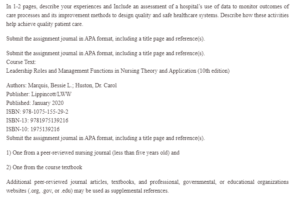Quality Improvement in Health Care Systems
Quality should be at the center of any healthcare service. Quality healthcare services enhance patient outcomes, improve patient satisfaction, and reduce healthcare costs. Quality improvement is one of the QSEN’s critical competencies. Quality improvement is defined as “using data to monitor the outcomes of care processes and use improvement methods to design and test changes to improve the quality and safety of healthcare systems continuously.” (Marquis & Huston, 2020).
In my nursing experiences, I have seen healthcare organizations implement strategies to ensure that quality improvement strategies are implemented. An example that stood out for me was using data to monitor the effectiveness of handwashing strategies to reduce hospital-acquired infections. The data used to monitor this strategy’s effectiveness was the number of antibiotics prescribed, length of hospitalizations, and the rate of nosocomial infections.
One method that hospitals can use to assess and compare the quality of their healthcare services is the Donabedian model. The measures in this model can be classified as structure, process, or outcome measures. Structural measures give patients a sense of the healthcare organization’s processes, systems, and capacity to provide quality healthcare services (Tossaint-Schoenmakers et al., 2021). Structural measures include using technology in healthcare, such as medication order entry systems or electronic health records, the number of board-certified doctors or nurses, and the ratio of physicians to patients.
Process measures indicate what healthcare organizations do to improve or maintain health for healthy individuals or those diagnosed with medical conditions (Tossaint-Schoenmakers et al., 2021). Process measures commonly reflected the accepted clinical guidelines for practice. Examples of process measures include the proportion of individuals who receive preventive healthcare services such as vaccinations or mammograms and the proportion of hypertensive patients who have their blood pressure measured and controlled. The process measures can inform healthcare consumers about the services they might expect to be offered for a specific disease or contribution. This can contribute to improving healthcare outcomes.
Outcome measures indicate the effects of healthcare interventions or services on the health status of their patients (Tossaint-Schoenmakers et al., 2021). Outcome measures include surgical mortality rates, i.e., the proportion of patients who died due to surgery or the rate of hospital-acquired infections or surgical complications. Outcomes measures are the gold standard for measuring quality. However, healthcare outcomes may be due to other factors outside healthcare providers’ control.
Healthcare organizations can thus use the data from the three outcome measures to implement strategies that can improve the quality of healthcare services. An example of data is the rate of hospital-acquired infections. If a hospital has high rates, a healthcare organization can implement quality improvement initiatives such as compulsory handwashing for healthcare professionals to reduce the rate of hospital-acquired infections. These activities improve the quality of care since healthcare professionals and organizations identify areas to improve the services. After identification, they can implement strategies to improve the safety and quality of healthcare services.
In conclusion, quality management is one of the QSEN competencies of nurses. Nurses should thus be at the center of quality improvement initiatives in their organizations. They can utilize the Donabedian model to guide them in areas to collect healthcare data. They can thus implement quality improvement strategies based on the data obtained. This data will illustrate the efficiency of quality improvement in healthcare settings.
References
Marquis, B. L., & Huston, C. (2020). Leadership roles and management functions in nursing: Theory and application (10th ed.). Lippincott Williams & Wilkins.
Tossaint-Schoenmakers, R., Versluis, A., Chavannes, N., Talboom-Kamp, E., & Kasteleyn, M. (2021). The challenge of integrating eHealth into health care: Systematic literature review of the Donabedian structure, process, and outcome model. Journal of Medical Internet Research, 23(5), e27180. https://doi.org/10.2196/27180
ORDER A PLAGIARISM-FREE PAPER HERE
We’ll write everything from scratch
Question
In 1-2 pages, describe your experiences and Include an assessment of a hospital’s use of data to monitor outcomes of care processes and its improvement methods to design quality and safe healthcare systems. Describe how these activities help achieve quality patient care.

Quality Improvement in Health Care Systems
Submit the assignment journal in APA format, including a title page and reference(s).
Submit the assignment journal in APA format, including a title page and reference(s).
Course Text:
Leadership Roles and Management Functions in Nursing Theory and Application (10th edition)
Authors: Marquis, Bessie L.; Huston, Dr. Carol
Publisher: Lippincott/LWW
Published: January 2020
ISBN: 978-1075-155-29-2
ISBN-13: 9781975139216
ISBN-10: 1975139216
Submit the assignment journal in APA format, including a title page and reference(s).
1) One from a peer-reviewed nursing journal (less than five years old) and
2) One from the course textbook
Additional peer-reviewed journal articles, textbooks, and professional, governmental, or educational organizations websites (.org, .gov, or .edu) may be used as supplemental references.

